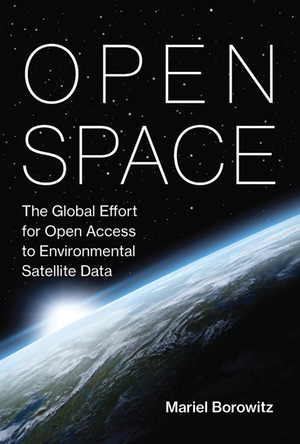Review: Open Spaceby Jeff Foust
|
| Agencies initially offered free access to data from their satellite systems for a variety of reasons. But, over time, as these systems demonstrated their value, their costs grew, putting pressure on the agencies to try to recover costs. |
The Weather Channel, of course, gets those images and other data from NOAA’s satellites, which shares that data widely. Likewise, the US Geological Survey, which operates the Landsat series of Earth observation satellites, now freely provides imagery from those satellites, after years of charging for access. And NASA’s Earth science satellites provide data heavily used by the scientific community. Other countries are also increasingly adopting “open data” policies for their Earth observation satellites.
How those policies developed since the early years of the Space Age is the subject of Open Space by Mariel Borowitz, a professor at Georgia Tech. In the book she analyzes the development of policies in the United States, Europe, Japan, and other nations regarding access to data from Earth observation satellites and fits that development into a broader policy framework.
Borowitz sees a common trend for Earth observation systems over the last several decades. Agencies initially offered free access to data from their satellite systems for a variety of reasons, from a need to evaluate the capabilities of these systems to a desire for national prestige and building the domestic and international reputation of the agencies.
But, over time, as these systems demonstrated their value, their costs grew, putting pressure on the agencies to try to recover costs. In the United States, this led to the commercialization of Landsat as well as a separate, short-lived effort to transfer NOAA weather satellites to the private sector. In Europe, EUMETSAT, the agency that operates weather satellites, enacted fees for access to data.
Those commercialization efforts failed because of a lack of demand. In addition, there was pressure from outside organizations that desired free and open sharing of data, such as the World Meteorological Organization, which passed a resolution in the mid-1990s that called on member nations to share “essential” weather data with each other without charge. Those factors, she argues, led agencies to shift back towards open data policies, as the pressures to reduce costs eased. (Technology advances helped, as computers and the Internet helped make the costs of providing data negligible, at least when compared to producing and shipping photographs or magnetic tapes.)
Today, open data policies tend to be the rule, even for systems operated by emerging nations. But into this world comes a large number of startups developing commercial remote sensing systems, some complementary to government systems and others potentially in competition with them. Those companies, with a desire to make money to fund their operations and provide a return to their investors, are unlikely to have the same free and open policies as government agencies. What will happen then?
Borowitz treats commercial systems with some skepticism. “However, after decades of experimentation with a variety of remote sensing technologies, to date, no commercial remote sensing endeavor has been able to survive without government support,” she writes. Some have required extensive government support, such as DigitalGlobe and its predecessors who had many of their satellites extensively subsidized by the National Geospatial-Intelligence Agency (NGA), who bought large amounts of imagery as well.
| “However, after decades of experimentation with a variety of remote sensing technologies, to date, no commercial remote sensing endeavor has been able to survive without government support,” she writes. |
The new generation of startups, though, are following a different path, relying on private and not government investment to deploy their systems. How well these ventures will do remains to be seen, but it’s clear they see government agencies as one potential customer, but not the only or even the largest. And government agencies are interested in at least experimenting with such capabilities: NGA has awarded contracts to Planet to access images from its constellation of satellites, and NOAA completed a first round of its commercial weather data pilot program last year with GeoOptics and Spire.
Those commercial systems, regardless of their commercial viability, aren’t replacements for government-developed systems that typically have far more exquisite sensors and exacting requirements for availability and accuracy. But if these commercial satellites do find traction in the market, it will be interesting to see how governments respond. Borowitz, in the book’s conclusion, suggests agencies and organizations make “direct investments of time, technology and funding” to improve access to open data and demonstrate their benefits. In any case, hopefully policymakers are smarter than the anonymous, perhaps mythical, congressman who suggested simply turning the channel.
